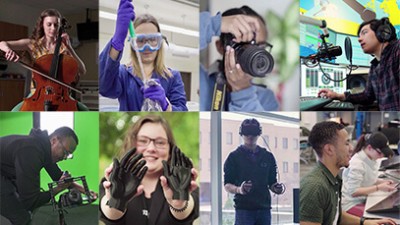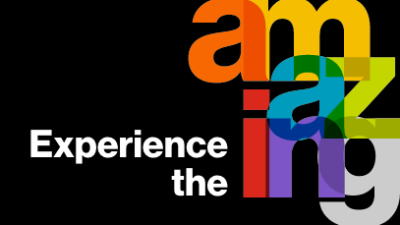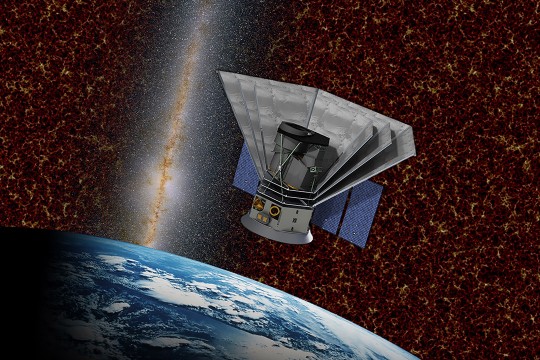News
Michael Zemcov
-
July 27, 2021
![students and professor working at a computer station.]()
Student team designs imaging system for CIBER-2 launches
Two electrical engineering students are refining an attitude control system and are seeking ways to reduce the impact of atmospheric heat that changes a spacecraft’s orientation during launch. Both students will share information about their work for CSTARS-2 during the 2021 Undergraduate Research Symposium.
-
June 17, 2021
![researcher making adjustments to a rocket.]()
CIBER-2 experiment successfully completes first flight
Led by principal investigator Michael Zemcov, an assistant professor in RIT’s School of Physics and Astronomy and Center for Detectors, the experiment aims to better understand extragalactic background light, which traces the history of galaxies back to the formation of the first stars in the universe.
-
June 3, 2021
![Time-lapse photograph of a rocket launch.]()
Rocket Team to Discern if Our Star Count Should Go Way Up
NASA talks to Michael Zemcov, assistant professor of physics and astronomy, about the amount of light in space coming from outside of galaxies.
-
May 12, 2021
![side-by-side portraits of students Emily Wilson and Teresa Symons.]()
RIT Outstanding Graduate Woman Achievement Award highlights Graduate Student Advisory Council leaders
RIT students Emily Wilson and Teresa Symons are co-recipients of the Outstanding Graduate Woman Achievement Award for their dedication and leadership on RIT’s Graduate Student Advisory Council. Wilson and Symons are Ph.D. students in the astrophysical sciences and technology program in the School of Physics and Astronomy and co-chairs of the Graduate Student Advisory Council.
-
January 6, 2021
![illustration of telescope in space.]()
RIT’s Michael Zemcov helping to push new NASA space telescope toward launch
Michael Zemcov, assistant professor in the School of Physics and Astronomy, is part of the Spectro-Photometer for the History of the Universe, Epoch of Reionization and Ices Explorer (SPHEREx) mission, which will let scientists learn about the formation of galaxies and search for life-sustaining molecules in the clouds of material where stars and planets form.
-
December 8, 2020
![cartoon drawing of two figures looking into the darkness of space.]()
Outer Space Just Got a Little Brighter
The New York Times talks to Michael Zemcov, assistant professor in the School of Physics and Astronomy, about a new study on light outside of known galaxies.
-
November 21, 2020
![NASA's New Horizons spacecraft.]()
Scientists Just Discovered Outer Space Isn’t Pitch Black
Travel and Leisure mentions Michael Zemcov, assistant professor in the School of Physics and Astronomy, regarding a new study on light outside of known galaxies.
-
November 18, 2020
![illustration of the New Horizons spacecraft in space.]()
Scientists Discover Outer Space Isn't Pitch Black After All
NPR talks to Michael Zemcov, assistant professor in the School of Physics and Astronomy, about a new study on light outside of known galaxies.
-
November 18, 2019
![Two researchers wearing cleansuits work on detector equipment.]()
Researchers prepare rocket for launch
A team of RIT researchers is helping launch an experiment above the atmosphere to better understand extragalactic background light, which traces the history of galaxies back to the formation of the first stars in the universe.
-
September 12, 2019
![Quanta Image Sensor (QIS) semiconductor chip.]()
Scientists developing single photon detector to help search for habitable exoplanets
NASA is awarding a team of researchers from RIT and Dartmouth College a grant to develop a detector capable of sensing and counting single photons that could be crucial to future NASA astrophysics missions. The extremely sensitive detector would allow scientists to see the faintest observable objects in space, such as Earth-like planets around other stars.
-
May 22, 2019
![Man building a rocket]()
Handsworth grad examines inner workings of outer space with NASA project
Assistant Professor Michael Zemcov interviewed by North Shore News for his part in contributing to NASA’s new mission to explore the origins of the universe by performing the first near-infrared all-sky spectral survey.
-
April 23, 2019
![Researchers stand in front of gigantic observatory.]()
RIT researchers help conduct experiment to study how the first stars and galaxies formed
While many people flock to warm destinations for spring break, two RIT experimental cosmologists spent theirs 6,800 feet high on snow-covered Kitt Peak at the Arizona Radio Observatory. They were deploying an instrument to a 12-meter telescope for a project called the Tomographic Ionized-carbon Mapping Experiment (TIME), which aims to study the universe’s first stars and galaxies.




















